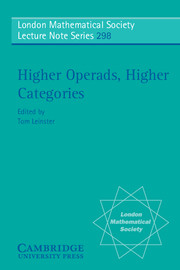Book contents
- Frontmatter
- Contents
- Diagram of interdependence
- Acknowledgements
- Introduction
- Motivation for topologists
- Part I Background
- Part II Operads
- 4 Generalized operads and multicategories: basics
- 5 Example: fc-multicategories
- 6 Generalized operads and multicategories: further theory
- 7 Opetopes
- Part III n-categories
- Appendices
- References
- Index of notation
- Index
6 - Generalized operads and multicategories: further theory
Published online by Cambridge University Press: 08 January 2010
- Frontmatter
- Contents
- Diagram of interdependence
- Acknowledgements
- Introduction
- Motivation for topologists
- Part I Background
- Part II Operads
- 4 Generalized operads and multicategories: basics
- 5 Example: fc-multicategories
- 6 Generalized operads and multicategories: further theory
- 7 Opetopes
- Part III n-categories
- Appendices
- References
- Index of notation
- Index
Summary
The last paragraph plays on the postmodern fondness for ‘multidimensionality’ and ‘nonlinearity’ by inventing a nonexistent field: ‘multidimensional (nonlinear) logic’.
Sokal and Bricmont (1998)This chapter is an assortment of topics in the theory of T -multicategories. Some are included because they answer natural questions, some because they connect to established concepts for classical operads, and some because we will need them later. The reader who wants to get on to geometrically interesting structures should skip this chapter and come back later if necessary; there are no pictures here.
In Section 6.1 we ‘recall’ some categorical language: maps between monads, mates under adjunctions, and distributive laws. This language has nothing intrinsically to do with generalized multicategories, but it will be efficient to use it in some parts of this chapter (Sections 6.2 and 6.7) and later chapters.
The first three proper sections each recast one of the principal definitions. In Section 6.2 we find an alternative definition of generalized multicategory, which amounts to characterizing a T -multicategory C by its free-algebra monad TC plus one small extra piece of data. Both Sections 6.3 and 6.4 are alternative ways of defining an algebra for a T -multicategory. The former generalizes the categorical fact that Set-valued functors can be described as discrete fibrations, and the latter the fact that a classical operad-algebra is a map into an endomorphism operad (often taken as the definition of algebra by ‘working mathematicians’ using operads). The next two sections are also generalizations. The free T -multicategory on a T -graph is discussed in Section 6.5. Abstract as this may seem, it is crucial to the way in which geometry arises spontaneously from category theory: witness the planar trees of Section 2.3 and the opetopes of Chapter 7.
- Type
- Chapter
- Information
- Higher Operads, Higher Categories , pp. 182 - 215Publisher: Cambridge University PressPrint publication year: 2004



